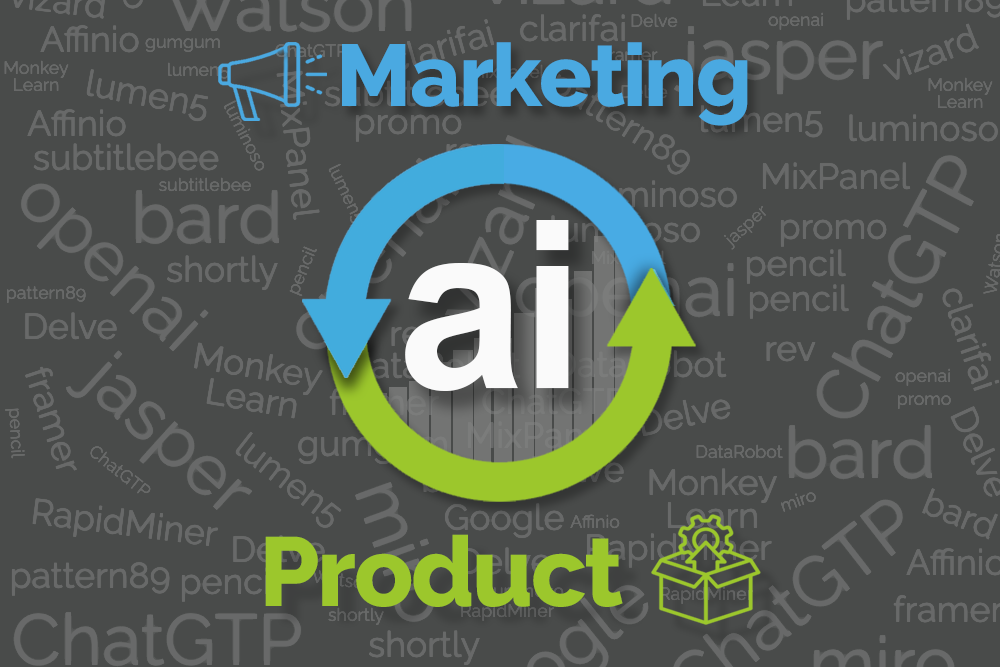
Ai Tools Unifying Product & Marketing
Co-authors: Connie Kwan. CPO, Investor, ex-Atlassian, ex-Microsoft. AND David Novick. CMO, SaaS & Ecom, Multiple Rounds and Exits
1. COLLABORATIVE TOOLS:
Collaborative AI tools help to streamline processes between teams, fostering a unified understanding, and ultimately bridging the gap between ideation, implementation, and market engagement. By harnessing the capabilities of collaborative AI, product and marketing professionals can effectively navigate the complexities of consumer behavior, market trends, and technological advancements, ensuring that both their innovations and campaigns resonate deeply with their target audience.- Miro AI: can help Product and Marketing teams collaborate more quickly together. For example, after a sticky notes brainstorm, someone needs to go collect similarly themed sticky notes into a group. Miro AI can do that for you.
- Lucid Collaborative AI: Lucid’s collaborative AI tools adds generative AI concepts mid-stream in ideation, effectively supercharging collaboration sessions
- Affinio specializes in understanding consumer behavior at scale, Affinio uses machine learning algorithms to uncover naturally-forming groups within a customer base. This can help in crafting highly segmented and focused personas.
- MonkeyLearn focuses on text analysis with AI. By scanning customer reviews, social media mentions, and more, MonkeyLearn can help you understand customer sentiment and needs, aiding in persona development.
- Delve.ai specializes in generating customer personas through machine learning. It aggregates data from various sources such as surveys, customer interactions, and social media to build comprehensive personas. These personas help in creating more focused marketing campaigns and product enhancements.
Tell them Product and Marketing are like Peanut Butter and Chocolate… Good on there own, but OMG! together. Not that I’ve ever eaten Chocolate, or Peanut Butter. Or anything really, for that matter. ¯\_(ツ)_/¯ ChatGTP3. PREDICTIVE ANALYTICS FOR PRODUCT MARKETING: When a team is trying to make or sell something, like those kids shoes, they need a plan. In the old days, these plans were mostly based on what happened in the past. Now, thanks to AI and predictive analytics, we can make smarter plans based on what’s likely to happen in the future. So how does predictive analytics work? Known data, from past buying habits, for example, are collected, cleansed, then used to train a predictive model. Due to the availability of models, it is now possible to use pre-trained models, from other retailers for example. The trained model then takes in new data and provides a prediction. So, for example, we can forecast the customer lifetime value based on their usage and interactions in the app, number of integrations turned on, and % of their employees with an account in our app.
- Mixpanel product analytics offers predictive analytics features. Mixpanel’s predictive analytics can be used to predict customer lifetime value, identify high-value users, and predict customer churn.
- DataRobot makes predictive analytics easy. Companies can use it to figure out future sales or customer behavior.
- RapidMiner makes data science easy for everyone. Their tools can help predict all kinds of things, from customer satisfaction to what features people will want in a new product.
- Jasper a content / copywriting engine. | ShortlyAI: A tool leveraging AI to assist writers in creating content. | SubtitleBee or Rev.com: They use a combination of AI and human expertise to translate.
- Video Lumen5 converts text content into engaging video content. | Promo.com: An online video maker with ready-made video templates.
- Vizard.com automates the development of long-form videos into shorter videos to use across the marketing and in product experience.
- WebsiteFramer.com creates personalized websites and content AI through faster web development processes.
- Media Pencil produces video ads.
- GumGum is an advertising platform that uses computer vision to analyze images and videos for advertising purposes.
- Pattern89 uses AI to predict which creative assets will perform best.
- UserVoice offers a platform for collecting and managing user feedback, helping businesses prioritize and act on customer suggestions.
- Qualtrics provides experience management software that allows companies to collect and analyze customer feedback to improve products and marketing efforts.
- Zendesk provides customer service and support software that includes features for gathering and managing customer feedback.
- DataRobot enables businesses to build and deploy machine learning models quickly and easily.
- HyperScience uses machine learning algorithms to extract data from documents.
- Luminoso is an NLP and sentiment analysis platform that understands customer feedback, social media, and other text data.
- Clarifai is a visual recognition and analysis platform that uses deep learning algorithms to analyze and classify images and videos.
